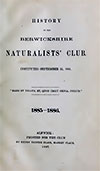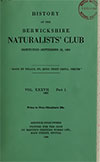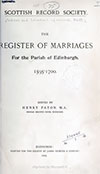

The remains of Leitholm Peel, a probable 16th century tower, stand in a field just to the east of Stainrigg.
The castle occupies a position at the north-east end of a ridge, presumably the Stainrigg or Stoneridge, between the Laprig Burn and the Petty Burn, and may have been surrounded by marshy land prior to agricultural improvements. When the first castle here was built is unclear, however the property has a long history going back to the 12th century.
Ketel de Letham, or Ketil of Letham, son of Dolfin and possibly cousin of Gospatric, witnessed documents in the late 12th century, and also owned the manor of Great Strickland over the border in England. Neither of Ketel’s sons had issue so his properties passed to his daughter Christina and her husband Walter fitz Adam, who may have been part of the De Vaux family of Dirleton Castle. However he may also be the same Walter who was described as the son of Robert of Ednam when he was granted the lands of Letham in feu by Durham Cathedral Priory around 1200.
Walter and Christina’s elder son, Adam fitz William, received the lands of Leitholm and his descendants took the name De Letham. Their younger son, Robert, received the lands of Great Strickland and his family took the name of De Strickland.
Sir John de Letham, Walter and Christina’s grandson, appears in charters of the Earls of Dunbar in the mid-13th century. A later Sir John de Letham is described as a knight early in the 14th century and was granted one year’s safe passage through England by Edward II so that he could go on pilgrimage to St. James of Compostela.
Edward de Letham was one of the Scottish hostages when Berwick was surrendered to Edward III in 1333, and later entered service with the English king so forfeiting his Scottish possessions. His estates were restored to him by an Act of the Scottish Parliament in 1364.
Legend has it that Robert II spent a night at Leitholm Peel, some time before 1390, supposedly to inspect the pearl beds in the Leet Water.
In 1403 the lands of Letham were granted by Robert III to a John Letham following their forfeiture by their hereditary overlord George, Earl of March. The male line of the De Lethams seems to have come to an end upon the death of this John, and it’s thought that Leitholm then passed to the Strickland family.
At some point in the 15th century Leitholm became the property of the Dicksons. Dickson family legend actually has it that the tower was built by them in 1390, although given that it was apparently owned by John Letham in 1403 this seems unlikely. One possible explanation is that the De Lethams temporarily forfeited the estate and the Dicksons took over.
Another perhaps more likely explanation is that, since Leitholm Peel is sometimes referred to as the West Tower, the De Lethams’ castle was actually further to the east in or around Leitholm village on the opposite side of the Leet Water and that what is now known as Leitholm Peel was in fact built by the Dicksons in 1390.
On Joan Blaeu’s map of 1654 a tower named Peell is marked between Belchester and Stanyrigs (Stainrigg). It is almost equidistant between the two however this may be artistic licence or inaccuracy as a result of the map being based on Timothy Pont’s often messy earlier work.

Joan Blaeu, Amsterdam, 1654map image courtesy of NLS
Whatever the truth, the Dicksons certainly owned Leitholm Peel in the 15th century, with a Pate Dickson being documented as the laird in 1470. It remained in the Dickson family until the 18th century when it passed to the Hunter family of Antonshill and Belchester (although I have seen a reference to it belonging to James Home, 3rd Earl of Home, in 1649).
Leitholm Peel is rectangular in plan, measuring around 9.1 metres north-east to south-west by around 7.3 metres north-west to south-east. The walls are some 1.2 metres thick, and built from rubble with dressed sandstone quoins. The north-west wall still stands to a height of around 6.0 metres however the south-east wall has been completely demolished and the other two walls remain to a lower height.
There is a doorway at ground level on the north-east wall while at first floor level on the north-west wall is a window opening with an internal arched detail and an aumbry within the wall. No evidence of vaulting is visible at ground level.
An early 16th century date has been proposed due to the entrance at ground floor level, earlier towers tending to have their entrance on the first floor for added protection, although it may incorporate or have replaced earlier work. However the ground floor entrance may have been for cattle, as with bastle houses in the surrounding area. Indeed it is said that Borderers drove their cattle here for protection.
The frightened flocks and herds are pent
Beneath the peel’s rude battlement.
The tower was razed by the Earl of Hertford in 1545, but whether or not it was rebuilt is unclear. The Dicksons owned several properties in the surrounding area so it may be that it was left in ruins, however the fact that it is marked on a mid-17th century map would suggest that it was habitable at that time. Also in 1700 Grizel Dickson, daughter of Robert Dickson of Peell, was married in Edinburgh to a writer named David Reid.
The womenfolk of the Dickson family were renowned for their good looks, which was commemorated in verse.
Twixt Bughtrig and Belchester,
Hatchetnize and Darnchester,
Leitholm and the Peel,
If ye canna get a wife betwixt these
Ye’ll ne’er do weel.
The separate mentions of Leitholm and the Peel perhaps lends credence to the theory that these were two distinct towers since all of the other places mentioned were also towers.
Stainrigg, 300 metres to the west-south-west of Leitholm Peel, is thought to have been built in 1631, possibly as a replacement for the old castle.
Alternative names for Leitholm Peel
Latham; Leitholm Tower; Letham; Lethame; Litem; Peel; Peell; Peil; Peill; Peill de Lethame; Peill de Lethem; The Peel; West Tower


















